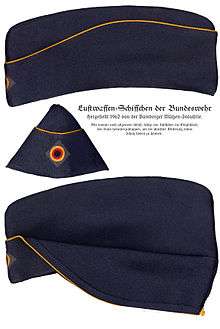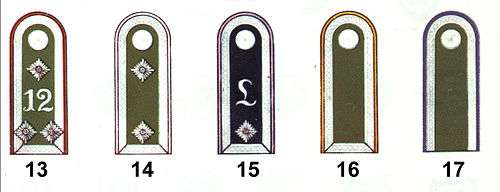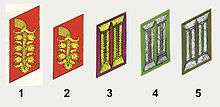Waffenfarbe

In the German military, Waffenfarbe (German: "corps colour") is a means the armed forces use to distinguish between different corps or troop functions in its armed services. The Waffenfarbe might be the colour of the collar patch, of the piping (coloured edging) around the shoulder boards or shoulder marks and — for enlisted ranks — of the piping around the collar and the garrison cap (Schiffchen). (In the latter places, NCO's wear cords of dark gold, officers silver, and generals gold.)[1]
Present
Army
The Bundeswehr uses a Waffenfarben scheme of colours to indicate troop types. The colours appear on the collar patch and as piping around the shoulder boards or straps showing a soldier’s rank.
Although soldiers’ berets are also coloured, the colours are slightly less differentiated than the waffenfarben, and corps or troop function is indicated by a beret badge rather than beret colour.
Waffenfarben of the Heer
-

Army Aviation
-

Technical Troops
-

Military band
-

Armoured Troops (i.e. Tanks)
-

Pioneers (i.e. Engineering)
-

Medical Troops
Air force

The Luftwaffe as the German air force only uses a small spectrum of colours. While the normal colour for the air force is a golden yellow, officers in the general staff service (today there is no general staff as such) wear wine-red, and generals bright red. The collar patches (Kragenspiegel) of generals and general staff service officers also differ from the normal air force design as they are identical with the army ones.
Navy
The German navy does not use function-specific colours to distinguish between corps. This is done instead by various emblems above the rank stripes on the sleeves.
History
Waffenfarben used by the Reichsheer (1921 to 1935)
| Regiment or Battalion type | Colour[2] |
|---|---|
| General Officers |
Scarlet (Hochrot) |
| Staff Corps of the Reichswehr Veterinary service |
Carmine (Karmesin) |
| Infantry | White |
| Motor transport | Rose-pink (Rosa) |
| Signals | Light brown |
| Cavalry | Golden yellow |
| Jäger (light infantry) | Dark green |
| Transport (horse-drawn) | Light blue |
| Medical service | Dark blue |
| Pioniere (Engineers) | Black |




Waffenfarben used by the Wehrmacht (1935 to 1945)
In German Heer and Luftwaffe there were a strictly defined systematic of corps colours on collar patchs, uniform piping and coloured edging around the shoulder boards or shoulder straps. The corps colours of the Reichswehr (1921 until ca. 1935) were almost identically to those of the Wehrmacht.
Waffenfarben used by the SS (1938 to 1945)
Waffenfarben worn by the National People's Army (1956 to 1990)
East German (DDR) Nationale Volksarmee uniforms initially wore the Waffenfarben as worn by the Wehrmacht. Between 1974 and 1979, along with the introduction of uniforms with open collar and tie, the patches of the ground force uniforms were unified with a dark grey base and a white filling, along with a white collar piping; the piping of the shoulder boards/shoulder straps remained the only part carrying a Waffenfarbe. However, air and air defence forces, paratroopers and generals as well as the navy continued to wear their specially designed and coloured patches.[4]
The uniform of the Border Troops was distinguished from that of the NVA ground force and Air Force/Air Defense Force by a green armband with large silver letters identifying the wearer's affiliation, and a green cap band.
Similarities in other armies
The use of colours to distinguish between troop functions was not unique to the Wehrmacht during World War II. The Soviet Army also used coloured shoulder boards after 1942 to distinguish troop functions: ground forces general officers and infantry used crimson, cavalry used blue, artillery and tank troops used red, and the rest of the ground forces used black, while the air force and airborne troops used sky blue. Likewise the British Army utilized coloured strips of cloth on the sleeves to likewise identify troop functions.
Today, Waffenfarbe schemes are also used in Austria, Finland, Hungary, Italy, Japan, Romania, and Switzerland. For a full list of troop function colours currently in use of the US Army, see United States Army branch insignia.
See also
References
- ↑ Official brochure on Bundeswehr uniforms (in German) (Waffenfarben of the army p. 14, of the air force p. 17)
- ↑ In addition to the colours, monograms and symbols were used to denominate services or units.
- ↑ The illustration erroneously depicts the NCO braid running around the lower edge of the collar, as on field uniforms. On actual dress uniforms the Tresse encircled the upper edge.
- ↑ Klaus-Ulrich Keubke, Manfred Kunz: Uniformen der Nationalen Volksarmee der DDR 1956-1986. Brandenburgisches Verlagshaus, Berlin 1990, p. 159, 175
- Glossary of German military terms
- Adolf Schlicht, John R. Angolia: Die deutsche Wehrmacht, Uniformierung und Ausrüstung 1933-1945
Vol. 1: Das Heer (ISBN 3613013908), Motorbuch Verlag, Stuttgart 1992
Vol. 3: Die Luftwaffe (ISBN 3-613-02001-7), Motorbuch Verlag, Stuttgart 1999
(very detailed information and discussion but no coloured images)
